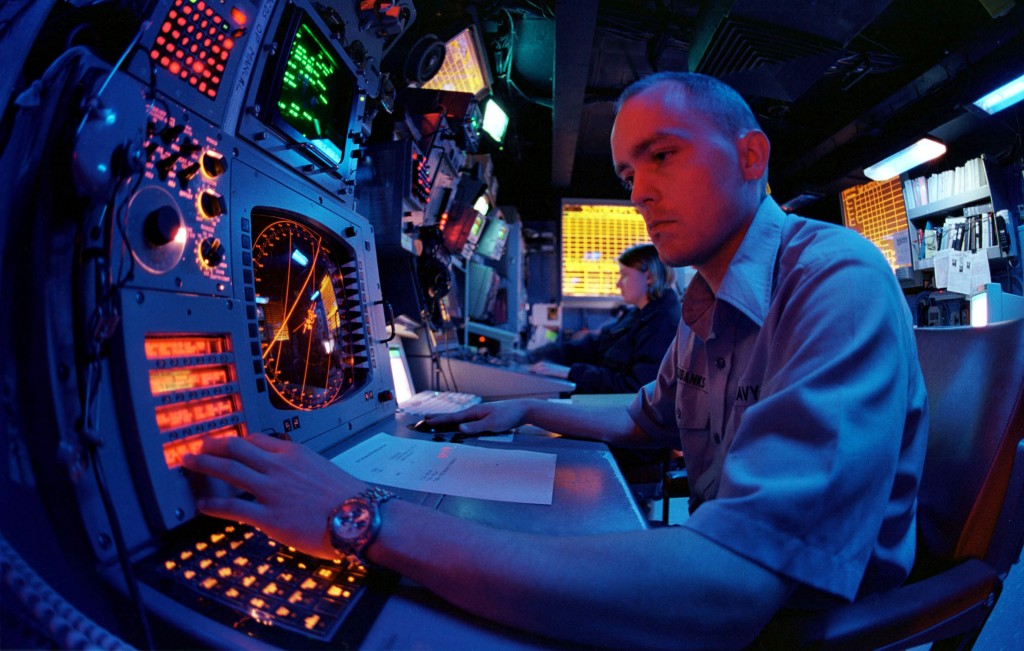Winning The War Of Electrons: Inside The New Maritime Strategy
Posted on

A Navy electronic warfare technician.
[UPDATED with comments from Rep. Randy Forbes, Cdr. Bryan Clark, & anonymous admiral]
WASHINGTON: We must win the war of electrons in a more dangerous world. That’s the stark imperative behind the bland title of the new maritime strategy released today by the Navy, Marine Corps, and Coast Guard.
“There is an offensive warfighting tone to this document that says, where the United States has interests, it needs access, [and] it can have that access,” said the new Commandant of the Marine Corps, Gen. Joseph Dunford, speaking this morning at the Center for Strategic and International Studies. What Dunford didn’t say explicitly, but the strategy does, is that we may have to fight for that access against increasingly sophisticated adversaries — including in cyberspace and the electromagnetic spectrum, domains where we long took dominance for granted.

Marine Commandant Gen. Joseph Dunford (left) and Chief of Naval Operations Adm. Jonathan Greenert (right)
Despite its benign title — “A Cooperative Strategy for 21st Century Seapower” — and plenty of boilerplate, the new strategy has a definite edge. In contrast to the 2007 strategy it replaces, which demurely didn’t mention any specific country as a threat, the new strategy calls out China, Russia, North Korea, and Iran by name. And in a departure from longstanding naval doctrine, it takes the traditional four functions of the fleet — deterrence, sea control, power projection, maritime security — and adds a fifth: “all-domain access.”
What does that mean? In essence, since the end of the Cold War, US forces have taken for granted their ability to go wherever they needed around the world, from the Strait of Taiwan and the mountains of Afghanistan to outer space and cyberspace. As potential adversaries like Russia, China, and even terrorist groups get better technology, that assumption is now far from safe. There’s been a great deal of discussion about defeating “anti-access/area denial” (A2/AD) threats, but the new strategy elevates the problem to almost the same priority as nuclear deterrence.
“It’s all well and good to want to project power, be a deterrent, and all of these things, but if you can’t get to where you need to get — which could be on the surface, under the sea, in space, you get my point: all the domains including cyber — you’ll be ineffective,” said Adm. Jonathan Greenert, the Chief of Naval Operations, at CSIS. “If you don’t have that [access] and it’s not a primary function that all of our kids are thinking about when they develop [professionally], when they organize, train, and equip, and operate, we will not necessarily be successful.”
Elevating all-domain access to a fifth core mission is not merely a rhetorical flourish. “When we look at [the] core functions,” Rear Adm. William McQuilkin told reporters in a preview of the strategy on Wednesday, “these are things that we man, train, and equip for.” (Man, train, and equip are the three defining missions of the armed services specified by law; operations fall under the joint combatant commanders). Adding all-domain access to the list, McQuilkin said, is an unmistakable way of saying “we think this is on par with the traditional core functions.”
That means All-Domain Access will take on new importance in the budget. “I will look at the building of the next POM through the lens of how this [strategy] is laid out,” Greenert said.

Rep. Randy Forbes
Greenert’s Legacy And The Budget
Adm. Greenert won’t actually be around for the submission of the 2017 budget request, however: His term as CNO ends this year. (He’ll probably retire). But the strategy enshrines ideas Greenert’s been advancing throughout his three-year term, especially about electronic and cyber warfare.
“None of the ideas [in the strategy] are that new,” one retired admiral told me, “[but] all are new since Greenert began his tour as CNO.”
“This will very much institutionalize the initiatives Adm. Greenert pursued as CNO, which is a great way to use a new strategy,” said Bryan Clark, a retired Navy commander and former Greenert advisor who worked on the strategy. In particular, he said, Greenert worked hard “elevating electromagnetic spectrum operations to the same level as other warfare areas such as anti-submarine warfare, anti-surface warfare, strike, etc. There is a groundswell around this idea now with the development of the Joint Concept for EM Spectrum Operations (JCEMSO), the DoD electronic warfare study, and plus-ups for EW and C4ISR systems in a down-budget fiscal environment. But the CNO was on the leading edge of it.”
“This is a document that will bode very well for his legacy,” agreed Rep. Randy Forbes, chairman of the House Armed Services subcommittee on seapower. “He has been not only very vocal but very committed to looking at different kinds of weapons systems that we’re going to need for tomorrow, including electromagnetic [warfare].”
By focusing on defeating high-end threats, the strategy also helps makes the case for more capable systems in general. In debates on individual programs, Forbes told me, the strategy supports his long-standing position that the carrier-launched UCLASS drone needs to be a combat aircraft, not a souped-up scout. In the debate over the federal budget and sequester, “I don’t expect people on the Ways and Means Committee will rush down to get this maritime strategy and read it over the weekend,” Forbes said, “but I think what it does is help us paint the picture to these members about why it is important for us to turn the [trend] lines about what we’ve been doing on national defense.”
Cdr. Clark was more skeptical about the potential impact on the Hill. “The strategy implies a renewed emphasis on higher-end military capabilities to address the return of [great power] geopolitics related to Russia and China,” he said. “Unfortunately, the strategy doesn’t clearly link the geopolitical trends to the need for these concepts and capabilities. This will make it harder for decision makers [to prioritize]. Every year items are marked on the Hill that were important elements of a strategic approach, but members and their staffs just couldn’t tell how they fit in. Stating clearly that because, for example, ‘China or Russia is doing X, we must do Y with Z capabilities’ would be very helpful in establishing priorities.”
 All-Domain Access
All-Domain Access
Foremost among the new strategy’s priorities is the new concept of all-domain access: securing freedom of action in sea, air, space, cyberspace, and the electromagnetic spectrum. “This is a huge deal,” Cdr. Clark said. All-domain access isn’t just joining the other four core missions of the Navy in the new strategy, he argued: It’s become the most central among them.
“If you were to flowchart it, power projection and sea control would flow into access, while deterrence and maritime security might flow out of it,” Clark said. “What the Navy is trying to describe…is the centrality of access as a function of the naval forces.”
“[It’s] a distinct change in the Navy’s strategic focus,” Clark said. “Establishing access..was what was expected of naval forces for decades, but was never clearly articulated,” he said. Then, after the fall of the Soviet Union, access could largely be assumed rather than fought for. Now, he said, “with the new strategy, access returns to center stage.”
So all-domain access is important — but what is it, exactly? As official documents tend to do, the description in the strategy degenerates into a laundry list. “It looks like many constituencies were trying to tie their activity to the function of all domain access,” said Cmdr. Clark. But there is still a strong unifying theme: electrons.
The strategy lists five aspects of all-domain access, all of which have a strong cyber or electronic warfare component:
Battlespace awareness, which requires “persistent surveillance” of not only the physical environment but cyberspace and the electromagnetic spectrum as well.
Assured command and control, which requires US communications networks to operate reliably and securely in the face of enemy jamming and hacking. Gen. Dunford specifically said Navy-Marine networks aren’t up to coordinating the kind of dispersed operations that have become routine and will require new investment.
Cyberspace operations, “including both defensive and offensive measures.”
Electromagnetic Maneuver Warfare, a new Navy concept for masking friendly emissions — radar, radio, and so on — and deceiving or disrupting the enemy’s.
Integrated fires, which seeks to reduce reliance on a limited supply of expensive missiles by using jamming, hacking, lasers, and rail guns.
What the new weapons and tactics will be remains, unsurprisingly, unspecified. “There’s a classified annex or two or three to be put together here to go to the next level and say ok, how do we deal with this regionally in more detail,” Greenert said. In the unclassified public strategy, he said when I asked him at CSIS, “it’s more conceptual, Sydney, in our approach — and it captures the very essence, in my opinion, of what started out to be the Air-Sea Battle concept.”
Air-Sea Battle began as a controversial concept for high-tech, high-intensity, long-range warfare by Air Force and Navy forces against a sophisticated adversary. Since then the Marines and Army came aboard, and the domesticated concept has been blandly renamed the Joint Concept for Access and Maneuver in the Global Commons. But its central concern — fighting enemies capable of challenging us in air, sea, space, and cyberspace — is now enshrined at the heart of the new strategy.
Updated 9:35 pm
Subscribe to our newsletter
Promotions, new products and sales. Directly to your inbox.
